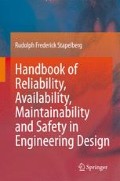Abstract
In the design of critical combinations and complex integrations of large engineering systems, their engineering integrity needs to be determined. Engineering integrity includes reliability, availability, maintainability and safety of inherent systems functions and their related equipment. The integrity of engineering design therefore includes the design criteria of reliability, availability, maintainability and safety of systems and equipment. The overall combination of these four topics constitutes a methodology that ensures good engineering design with the desired engineering integrity. This methodology provides the means by which complex engineering designs can be properly analysed and reviewed, and is termed a RAMS analysis. The concept of RAMS analysis is not new and has been progressively developed, predominantly in the field of product assurance. Much consideration is being given to engineering design based on the theoretical expertise and practical experiences of chemical, civil, electrical, electronic, industrial, mechanical and process engineers, particularly from the point of view of ‘what should be achieved’ to meet design criteria. Unfortunately, not enough consideration is being given to ‘what should be assured’ in the event design criteria are not met. Most of the problems encountered in engineered installations stem from the lack of a proper evaluation of their design integrity. This chapter gives an overview of methodology for determining the integrity of engineering design to ensure that consideration is given to ‘what should be assured’ through appropriate design review techniques. Such design review techniques have been developed into automated continual design reviews through intelligent computer automated methodology for determining the integrity of engineering design. This chapter thus also introduces the application of artificial intelligence (AI) in engineering design and gives an overview of artificial intelligence-based (AIB) modelling in designing for reliability, availability, maintainability and safety to provide a means for continual design reviews throughout the engineering design process. These models include a RAM analysis model, a dynamic systems simulation blackboardmodel, and an artificial intelligence-based (AIB) blackboard model.
Access this chapter
Tax calculation will be finalised at checkout
Purchases are for personal use only
Preview
Unable to display preview. Download preview PDF.
Rights and permissions
Copyright information
© 2009 Springer London
About this chapter
Cite this chapter
(2009). Design Integrity Methodology. In: Handbook of Reliability, Availability, Maintainability and Safety in Engineering Design. Springer, London. https://doi.org/10.1007/978-1-84800-175-6_1
Download citation
DOI: https://doi.org/10.1007/978-1-84800-175-6_1
Publisher Name: Springer, London
Print ISBN: 978-1-84800-174-9
Online ISBN: 978-1-84800-175-6
eBook Packages: EngineeringEngineering (R0)

